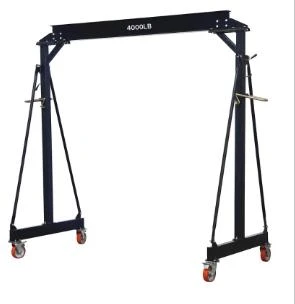movable overhead crane
Understanding the Movable Overhead Crane An Essential Tool in Modern Industries
In today’s rapidly evolving industrial landscape, efficiency and safety are paramount. One of the most essential tools that contribute to these goals is the movable overhead crane. This piece of equipment has become indispensable in various sectors, including manufacturing, construction, shipping, and warehousing. In this article, we will explore the features, benefits, applications, and considerations surrounding movable overhead cranes.
What is a Movable Overhead Crane?
A movable overhead crane is a type of crane that consists of a beam or girder running along rails mounted on columns or walls. The crane hoist, also known as the trolley, moves horizontally along the beam. Unlike fixed cranes, movable overhead cranes can be relocated within a designated area, allowing for greater flexibility in handling materials and loads. These cranes are designed to lift and transport heavy loads vertically and horizontally, making them integral to various operations.
Key Features
1. Design Variability Movable overhead cranes come in various configurations, including single girder and double girder designs. Single girder cranes are typically lightweight and suitable for lighter loads, while double girder cranes offer enhanced strength and stability for heavier lifting applications.
2. Flexibility They can be moved along a defined track, enabling operators to handle materials from different workstations without needing to relocate machinery.
3. Safety Systems Modern movable overhead cranes are equipped with advanced safety features such as limit switches, overload protection systems, and emergency stop buttons. These systems ensure that operators can work with confidence, knowing that safety is prioritized.
4. Automation Options With technological advancements, many movable overhead cranes now offer automation capabilities, allowing for remote control and precise load handling, which enhances efficiency and reduces human error.
Benefits of Movable Overhead Cranes
1. Increased Efficiency The ability to transport heavy loads quickly and accurately can significantly reduce cycle times in various processes. This translates to improved productivity and output in manufacturing and logistics.
3. Space Optimization By utilizing vertical space through overhead lifting, these cranes facilitate more efficient use of floor space, allowing for better organization of work areas.
movable overhead crane

4. Versatile Applications Movable overhead cranes can be employed in a range of industries. Whether it’s in a factory setting for assembly line work, in warehouses for moving goods, or on construction sites for heavy lifting, these cranes are exceptionally versatile.
Applications in Various Industries
Movable overhead cranes are utilized across multiple sectors, including
- Manufacturing They assist in the assembly and movement of parts along production lines, enhancing workflow efficiency. - Construction These cranes handle heavy materials such as steel beams and concrete blocks, ensuring that construction projects proceed smoothly. - Shipping and Logistics In ports and warehouses, movable overhead cranes are crucial for loading and unloading cargo, managing inventory, and ensuring efficient logistics operations.
Considerations When Implementing Movable Overhead Cranes
While the benefits of movable overhead cranes are significant, organizations must consider several factors before implementation
1. Space Requirements The installation of overhead cranes necessitates adequate ceiling height and sufficient space for movement along tracks.
2. Load Capacity Determining the maximum load requirements is crucial, as selecting the appropriate crane type and capacity is essential for operational safety.
3. Maintenance Regular inspections and maintenance are vital to ensure optimal performance and longevity of the crane.
4. Operator Training Adequate training for operators is essential to maximize safety and efficiency. Understanding the operational mechanics and safety protocols is crucial for minimizing risks.
Conclusion
Movable overhead cranes represent a significant advancement in material handling technology. Their ability to enhance efficiency, improve safety, and provide operational flexibility makes them a valuable asset in today's industrial operations. As industries continue to evolve, the role of movable overhead cranes will undoubtedly remain pivotal in shaping the future of material transportation and management.
-
Unlock Seamless Relocation with Our Heavy Equipment Moving ExpertiseNewsJun.06,2025
-
Unleash Unrivaled Flexibility with Our Adjustable Gantry CraneNewsJun.06,2025
-
Unleash Heavy-Duty Efficiency with Our Industrial Gantry Crane SolutionsNewsJun.06,2025
-
Revolutionize Steel Handling with Our Magnetic Lifter RangeNewsJun.06,2025
-
Master Equipment Mobility with Premium Machinery Mover SolutionsNewsJun.06,2025
-
Elevate Your Material Handling with Magnetic Lifter TechnologyNewsJun.06,2025
-
YS Permanent Lifting Magnets: The Smarter Way to Handle SteelNewsMay.22,2025
